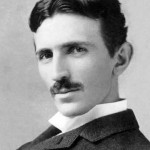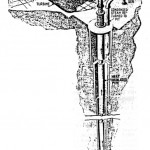 Nikola Tesla believed that the thermo-dynamic process, i.e., the burning of fossil fuels, was “wasteful and barbarous.” He foresaw the limitations on supply and the inherent dangers to man and the environment (though even Tesla couldn’t anticipate the impacts of fossil fuels on climate change). “Whatever our resources of primary energy may be in the future,” Tesla argued, “we must, to be rational, obtain it without consumption of any material.” He believed that natural, renewable, sources of energy could “eliminate the need of coal, oil, gas or any other of the common fuels.” Two of the renewable energy sources that he investigated were hydrothermal and geothermal energy.
Nikola Tesla believed that the thermo-dynamic process, i.e., the burning of fossil fuels, was “wasteful and barbarous.” He foresaw the limitations on supply and the inherent dangers to man and the environment (though even Tesla couldn’t anticipate the impacts of fossil fuels on climate change). “Whatever our resources of primary energy may be in the future,” Tesla argued, “we must, to be rational, obtain it without consumption of any material.” He believed that natural, renewable, sources of energy could “eliminate the need of coal, oil, gas or any other of the common fuels.” Two of the renewable energy sources that he investigated were hydrothermal and geothermal energy.
Tesla recognized that natural heat differentials exist in all three compartments of the environment – the oceans, the earth, and the atmosphere. Tesla saw the potential for a whole new source of energy from nature.
Hydrothermal
Tesla spent a great deal of effort determining a way to harness the temperature differential of the deep seas for power. The basic idea is that the “warmth of one layer” would be “brought into contact with the cold of another, to operate great power plants.” Tesla felt that such a system was practical to develop and operate. While he does discuss other natural sources of energy in his 1931 article “Our Future Motive Power,” most of the article is dedicated to analysis of the theory and practicality of hydrothermal energy from the sea.
Tesla dove into the project with his usual zeal, determined to create something completely new. The basic system relied on an apparatus that had existed for over a century, the cryophorus (“cold carrier”). It consisted of two large glass bulbs connected by a glass tube. The bulbs are partially filled with liquid, one bulb packaged in ice, “which is evaporated in one and condensed in the other.” After many calculations he felt the system could generate massive amounts of power
Tesla was elated. What a discovery!
Geothermal
 There are temperature differentials in the earth as well. In 1900 Tesla was already contemplating what today we call geothermal energy. In a somewhat long-winded and metaphysical treatise called “The Problem of Increasing Human Energy,” Tesla wrote that “it is a well-known fact that the interior portions of the globe are very hot, the temperature rising, as observations show, with the approach to the center at the rate of approximately 1 degree C. for every hundred feet of depth.”
There are temperature differentials in the earth as well. In 1900 Tesla was already contemplating what today we call geothermal energy. In a somewhat long-winded and metaphysical treatise called “The Problem of Increasing Human Energy,” Tesla wrote that “it is a well-known fact that the interior portions of the globe are very hot, the temperature rising, as observations show, with the approach to the center at the rate of approximately 1 degree C. for every hundred feet of depth.”
Several scientists and adventurously minded dreamers had sought ways to harness this natural energy. French astronomer and physicist M. Camille Flammarion, for example, suggested that a massive hole could be bored through the crust of the earth to “sap the inexhaustible supply of heat” believed present in the Earth’s core. Among other complications, Flammarion’s idea had one huge drawback – the opening to the shaft would need to be “two hundred to three hundred yards, supported by a heavy, thick, cast-iron lining.” Flammarion insisted this plan was “practicable and possible;” in reality it was closer to delusional.
Tesla, on the other hand, felt the basic temperature differential principle was sound and that with his own discoveries (e.g., use of volatile fluids), very small diameter holes and shallow depths would be sufficient to power populated areas. Tesla felt the only requirement still to be met was “to find some economic and speedy way of sinking deep shafts.” If that could be achieved it would “open up unlimited resources of power throughout the world.”
By this time, however, Tesla was in his 75th year and without a laboratory or funds to be doing any groundbreaking research. He decided that developing these natural energy technologies “must be left to the future” and someone else. He also recognized that our energy infrastructure had already swayed toward use of “cheap” coal and oil, and that government and financial support for fossil fuels would make development of renewable resources more difficult. Even with these realities, Tesla was already anticipating the day when “our stores of coal and oil will be eventually used up” and other more sustainable energy resources would be necessary.
[The extract above comes from my e-book, Nikola Tesla: Renewable Energy Ahead of Its Time. The book is available for download on Amazon.]
David J. Kent is the author of Tesla: The Wizard of Electricity and the ebook Nikola Tesla: Renewable Energy Ahead of Its Time.
Follow me by subscribing by email on the home page. And feel free to “Like” my Facebook author’s page and connect on LinkedIn. Share with your friends using the buttons below.










